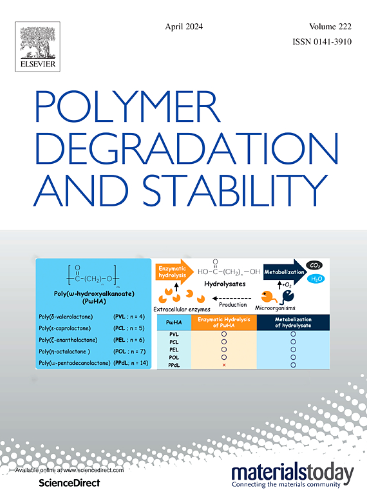通过碳酸三亚甲酯与对二噁烷酮简单有效的共聚提高聚(碳酸三亚甲酯)的降解性能
IF 6.3
2区 化学
Q1 POLYMER SCIENCE
引用次数: 0
摘要
生物可降解聚合材料在临床医学领域发挥着重要作用。然而,开发性能优异、降解特性可控的无毒高分子材料仍是一项挑战。本文通过碳酸三亚甲基酯(TMC)和对二噁烷酮(PDO)的无规共聚,制备了一系列可生物降解和生物吸收的聚(碳酸三亚甲基酯-对二噁烷酮)[P(TMC-co-PDO),PTD]共聚物作为聚合物材料。由黑曲霉脂肪酶介导的体外酶降解表明,通过调节组合物中 PDO 的含量,PTD 聚合物材料具有可控的降解率和良好的成型稳定性。研究人员从分子层面详细探讨了 PTD 共聚物的化学结构与最终性能之间的关系。结果表明,PDO 的引入可显著增强低分子量 PTMC 的成型稳定性,并明显加快其降解速度。这一举措为低分子量 PTMC 的改性和广泛应用提供了可行的策略。预计这种 PTD 有望成为临床聚合物植入式给药系统的候选材料。本文章由计算机程序翻译,如有差异,请以英文原文为准。

Enhancing the degradation properties of poly (trimethylene carbonate) by simple and effective copolymerization of trimethylene carbonate with p-dioxanone
Biodegradable polymeric materials play an important role in the field of clinical science. However, the advancement of non-toxic polymeric materials with excellent performance and controlled degradation properties remains a challenge. Herein, a series of biodegradable and bioresorbable poly (trimethylene carbonate-co-p-dioxanone) [P(TMC-co-PDO), PTD] copolymers were prepared as polymer materials through random copolymerization of trimethylene carbonate (TMC) and p-dioxanone (PDO). In vitro enzymatic degradation mediated by aspergillus oryzae lipase showed that PTD polymer materials exhibit a controllable degradation rate and well form-stability by regulating the PDO content in the composition. The relationship between the chemical structure and the final performance of the PTD copolymers at the molecular level was studied in detail. The results indicate that the introduction of PDO significantly enhances the form-stability of low molecular weight PTMC and significantly accelerates its degradation rate. This initiative provides a feasible strategy for the modification and extensive application of low molecular weight PTMC. It is envisioned that this PTD is a promising candidate for clinical polymer implantable drug delivery systems.
求助全文
通过发布文献求助,成功后即可免费获取论文全文。
去求助
来源期刊

Polymer Degradation and Stability
化学-高分子科学
CiteScore
10.10
自引率
10.20%
发文量
325
审稿时长
23 days
期刊介绍:
Polymer Degradation and Stability deals with the degradation reactions and their control which are a major preoccupation of practitioners of the many and diverse aspects of modern polymer technology.
Deteriorative reactions occur during processing, when polymers are subjected to heat, oxygen and mechanical stress, and during the useful life of the materials when oxygen and sunlight are the most important degradative agencies. In more specialised applications, degradation may be induced by high energy radiation, ozone, atmospheric pollutants, mechanical stress, biological action, hydrolysis and many other influences. The mechanisms of these reactions and stabilisation processes must be understood if the technology and application of polymers are to continue to advance. The reporting of investigations of this kind is therefore a major function of this journal.
However there are also new developments in polymer technology in which degradation processes find positive applications. For example, photodegradable plastics are now available, the recycling of polymeric products will become increasingly important, degradation and combustion studies are involved in the definition of the fire hazards which are associated with polymeric materials and the microelectronics industry is vitally dependent upon polymer degradation in the manufacture of its circuitry. Polymer properties may also be improved by processes like curing and grafting, the chemistry of which can be closely related to that which causes physical deterioration in other circumstances.
 求助内容:
求助内容: 应助结果提醒方式:
应助结果提醒方式:


